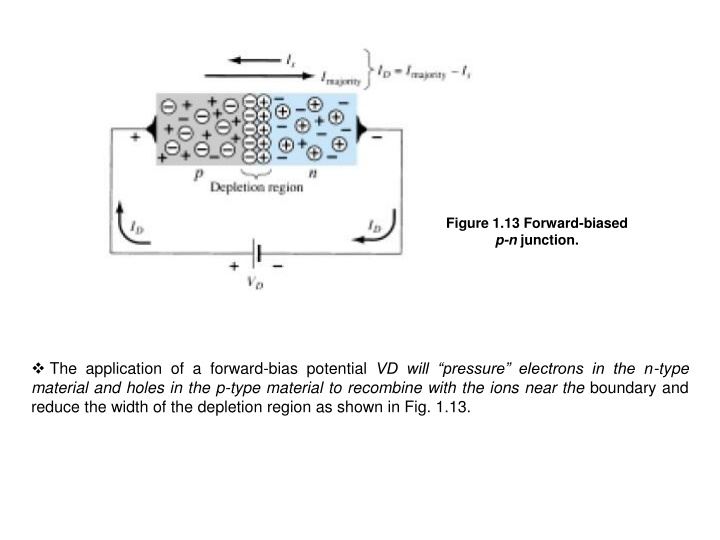
Understanding Semiconductor Diodes and Junctions
Explore the operation of forward-biased p-n junctions and characteristics of silicon semiconductor diodes, including equations for forward and reverse bias regions. Learn about thermal voltage and its calculation, illustrated with an example at a common operating temperature.
Download Presentation

Please find below an Image/Link to download the presentation.
The content on the website is provided AS IS for your information and personal use only. It may not be sold, licensed, or shared on other websites without obtaining consent from the author. If you encounter any issues during the download, it is possible that the publisher has removed the file from their server.
You are allowed to download the files provided on this website for personal or commercial use, subject to the condition that they are used lawfully. All files are the property of their respective owners.
The content on the website is provided AS IS for your information and personal use only. It may not be sold, licensed, or shared on other websites without obtaining consent from the author.
E N D
Presentation Transcript
Figure 1.13 Forward-biased p-n junction. The application of a forward-bias potential VD will pressure electrons in the n-type material and holes in the p-type material to recombine with the ions near the boundary and reduce the width of the depletion region as shown in Fig. 1.13.
sulting in an exponential rise in current as shown in the forward-bias region of the characteristics of Fig. 1.14. Note that the vertical scale of Fig. 1.14 is measured in milliamperes (although some semiconductor diodes will have a vertical scale measured in amperes) and the horizontal scale in the forward-bias region has a maximum of 1 V. Typically, therefore, the voltage across a forward-biased diode will be less than 1 V. Note also, how quickly the current rises beyond the knee of the curve. semiconductor diode can be defined by the following equation for the forward- and reverse-bias regions: where: Is = reverse saturation current. VD: is the applied forward - bias voltage across the diode. : is an ideality factor, which is a function of the operating conditions and physical construction; it has a range between 1 & 2 depending awide variety of factors ( =1 will be assumed throughout this text unless otherwise noted) The voltage VTin Eq.(1-1) is called the thermal voltage is determined by: Where: K: is Boltzmann's constant = 1.38*10-23J/K T: is the absolute temperature in Kelvins = 273+temperture C0 q: is the magnitude of electronic charge = 1.6*10-19 C
Example 1.1: At temperature of 270C (common temperature for components in an enclosed operating system). Determine the thermal voltage VT? Solution: Substituting in to Eq.(1 - 2), we obtain T = 273 + C0= 273 + 27 = 300K For positive values of VDthe first term of the above equation will grow very quickly For negative values of atV = 0v, Eq.(1-1) becomes






















